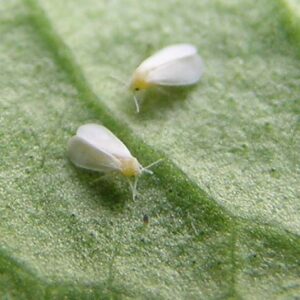Maintaining a thriving garden in America often involves battling various pests that can wreak havoc on plants. Understanding these common culprits and implementing effective prevention and control measures is key to safeguarding your garden’s health.
Whiteflies

Identification
Physical Characteristics: Whiteflies are small, winged insects resembling tiny moths. They measure about 1/16th to 1/10th of an inch in length.
Location on Plants: They are commonly found on the undersides of leaves, often in large groups. When disturbed, they fly up in a cloud-like manner, hence the name “whitefly.”
Damage
Feeding Behavior: Whiteflies feed on the sap of plants by piercing and sucking the phloem, the plant’s vascular system. Their feeding weakens plants and inhibits their ability to photosynthesize, leading to symptoms such as yellowing, wilting, and reduced vigor.
Honeydew Residue: Whiteflies excrete a sugary, sticky substance known as honeydew while feeding. This residue encourages the growth of sooty mold, a black fungus that can cover leaves and inhibit photosynthesis.
Prevention and Control Strategies
Monitoring and Early Detection:
Regular Inspection: Regularly examine the undersides of leaves for signs of whiteflies, particularly in plants they commonly infest.
Cultural Practices:
Pruning Infested Leaves: Remove heavily infested leaves or parts of the plant to limit the spread of whiteflies.
Natural Predators and Beneficial Insects:
Attract Beneficials: Encourage the presence of natural predators such as ladybugs, lacewings, and parasitic wasps by planting companion plants or providing suitable habitats.
Mechanical Control:
Hosing Off: Use a strong stream of water to dislodge and remove whiteflies from plants.
Organic Solutions:
Insecticidal Soap or Neem Oil: Apply these organic solutions, which suffocate and disrupt the pests’ cell membranes, effectively reducing whitefly populations.
Chemical Control (if necessary):
Consider using pesticides as a last resort, opting for those specifically designed for whitefly control and applying them according to recommended guidelines to minimize impact on beneficial insects.
Implementing a combination of these methods, particularly early detection and natural control measures, is essential for managing whitefly infestations effectively while preserving the overall health of garden plants and minimizing potential damage.
Caterpillars
Identification:
Larval Stage of Butterflies/Moths: Caterpillars are the larval stage of butterflies or moths. They have soft bodies, numerous legs, and distinct head capsules.
Feeding Behavior: Caterpillars are voracious feeders that consume plant foliage and stems. They vary in appearance based on species, with diverse colors and patterns.
Damage:
Chewing Damage: Caterpillars feed on leaves and stems, causing visible damage characterized by holes, chewed edges, and sometimes complete defoliation. Severe infestations can lead to skeletonized foliage, weakening plants and affecting their overall health.
Prevention and Control Strategies:
Physical Removal:
Hand-Picking: Visually inspect plants regularly and manually remove caterpillars from leaves and stems.
Biological Controls:
Natural Predators: Encourage the presence of natural predators such as birds, parasitic wasps, and predatory insects that feed on caterpillars.
Organic Solutions:
Bacillus thuringiensis (Bt): Apply Bt, a naturally occurring soil bacterium, which specifically targets caterpillars, causing them to stop feeding and perish.
Protective Measures:
Row Covers: Use physical barriers like row covers to prevent adult moths or butterflies from laying eggs on susceptible plants.
Cultural Practices:
Plant Diversity: Create diverse plantings to attract beneficial insects that keep caterpillar populations in check.
By employing a combination of these strategies, gardeners can effectively manage caterpillar populations and minimize the damage they cause to garden plants, promoting a healthy and thriving garden ecosystem.
Spider Mites
Identification:
Tiny Arachnids: Spider mites are minuscule arachnids, barely visible to the naked eye, typically measuring around 0.5 millimeters. They often cluster on the undersides of leaves.
Webbing and Stippling: Infested plants may show signs of fine webbing, especially in heavy infestations. Additionally, spider mites cause stippling, tiny pale spots on leaves caused by their piercing-sucking mouthparts.
Damage:
Sap-Sucking Activity: Spider mites feed on plant sap by piercing the leaf cells. This feeding disrupts the plant’s ability to photosynthesize, leading to symptoms such as yellowing, bronzing, and drying out of leaves.
Webbing as Protection: They produce webbing as a protective mechanism, forming a fine silk-like structure that helps them colonize and shelter themselves from natural enemies.
Prevention and Control Strategies:
Early Detection:
Frequent Inspection: Regularly examine the undersides of leaves for signs of spider mites, particularly in warm and dry conditions that favor their proliferation.
Cultural Practices:
Maintaining Plant Health: Ensure plants are well-watered and adequately fertilized, promoting their vigor and making them less susceptible to infestation.
Natural Predators:
Encourage Predators: Attract beneficial insects like ladybugs, predatory mites, and lacewings that feed on spider mites, helping to control their population.
Mechanical Control:
Hosing Off: Use a strong stream of water to wash off spider mites from plant leaves, reducing their numbers.
Organic Solutions:
Neem Oil or Insecticidal Soap: Apply these organic remedies, which suffocate and disrupt the mites’ cell membranes, effectively reducing their population.
Chemical Control (if necessary):
Acaricides: Consider using specific pesticides labeled for spider mite control as a last resort, following recommended guidelines to minimize non-target impacts.
By combining vigilant monitoring, cultural practices to boost plant health, and the targeted application of organic or, if needed, chemical remedies, gardeners can effectively manage and suppress spider mite populations, safeguarding the health of their garden plants.
Final Words
Regular monitoring and prompt action are vital in pest management. Integrated Pest Management (IPM) strategies that combine various methods offer the most effective and environmentally friendly approach to controlling pests in American gardens. By understanding the pests and employing preventive measures, gardeners can foster a healthy and flourishing garden ecosystem.


